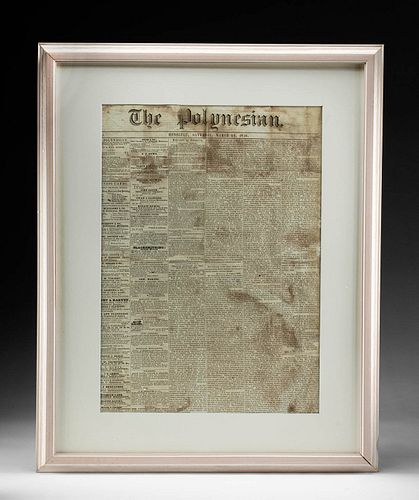Framed 1850 Hawaiian "The Polynesian" Newspaper Page
Lot 241
About Seller
Artemis Fine Arts
686 S Taylor Ave, Ste 106
Louisville, CO 80027
United States
Selling antiquities, ancient and ethnographic art online since 1993, Artemis Gallery specializes in Classical Antiquities (Egyptian, Greek, Roman, Near Eastern), Asian, Pre-Columbian, African / Tribal / Oceanographic art. Our extensive inventory includes pottery, stone, metal, wood, glass and textil...Read more
Categories
Estimate:
$15,000 - $22,500
Absentee vs Live bid
Two ways to bid:
- Leave a max absentee bid and the platform will bid on your behalf up to your maximum bid during the live auction.
- Bid live during the auction and your bids will be submitted real-time to the auctioneer.
Bid Increments
| Price | Bid Increment |
|---|---|
| $0 | $25 |
| $300 | $50 |
| $1,000 | $100 |
| $2,000 | $250 |
| $5,000 | $500 |
| $10,000 | $1,000 |
| $20,000 | $2,500 |
| $50,000 | $5,000 |
| $100,000 | $10,000 |
| $200,000 | $20,000 |
About Auction
By Artemis Fine Arts
Mar 24, 2022
Set Reminder
2022-03-24 10:00:00
2022-03-24 10:00:00
America/New_York
Bidsquare
Bidsquare : Exceptional Antiquities Ethnographic Fine Art
https://www.bidsquare.com/auctions/artemis-gallery/exceptional-antiquities-ethnographic-fine-art-9057
Museum-worthy examples of classical antiquities (Egyptian, Greek, Roman, Near Eastern), Viking, Far East / Asian, Pre-Columbian, African / Tribal, Oceanic, Native American, Spanish Colonial, Fossils, Ancient Jewelry, Fine / Visual Arts, so much more! Artemis Fine Arts info@artemisfinearts.com
Museum-worthy examples of classical antiquities (Egyptian, Greek, Roman, Near Eastern), Viking, Far East / Asian, Pre-Columbian, African / Tribal, Oceanic, Native American, Spanish Colonial, Fossils, Ancient Jewelry, Fine / Visual Arts, so much more! Artemis Fine Arts info@artemisfinearts.com
- Lot Description
North Pacific, Hawaiian Islands, Honolulu, ca. 1850. A page from the newspaper the "The Polynesian" published on March 23rd, 1850, re-counting an attempt by French Forces to take over Hawaii as a territory. The left side contains two columns of advertisements for merchants and a third column with notices, and the main article starts halfway down this column, titled "The French Outrage." The article is reprinted from the "Boston Evening Traveler" and describes the events leading up to the sacking of Honolulu by the French and includes a letter that the French consul, Guillaume Patrice Dillon, sent to the French Foreign Office. The subsequent invasion of Honolulu in 1848 by French Marines under Louis Tromelin was a direct result of Dillon's hostility towards the Hawaiian Government for the treatment of Catholics and other perceived injustices. This page is an astonishing document that contains history of the Hawaiian Islands is largely forgotten today. Size (page): 21" L x 14.75" W (53.3 cm x 37.5 cm); (frame): 29.25" L x 23.5" W (74.3 cm x 59.7 cm)
"The Polynesian" was a weekly newspaper started by an American editor publisher and editor in Honolulu, the first series ran from 1840 to 1841, when it contained little more than advertisements. After the paper was restarted in 1844, "The Polynesian" became the official publication of the Hawaiian Kingdom in 1845 when the Hawaiian government bought the paper and declared the subsequent editions to be the "Official Journal of the Hawaiian Government." While printed under the Hawaiian government the paper was still a commercial enterprise intended mainly for Honolulu's foreign or American residents, and the editors were non-native and pushed the paper to promote Western ideas and many articles were heavily ethnocentric. The Polynesian represents the conflict and strains that Hawaiians and foreigners were experiencing as the many cultures tried to cohabit the islands. The paper served to spread local and international news, business, and publicize laws, criminal codes, and policies of Kamehameha III and his successor, King Kamehameha IV. This page is an invaluable resource for a historical event that few outside the islands know!
This piece has been searched against the Art Loss Register database and has been cleared. The Art Loss Register maintains the world's largest database of stolen art, collectibles, and antiques.
Provenance: private Hawaii, USA collection, 1995 to 2010
All items legal to buy/sell under U.S. Statute covering cultural patrimony Code 2600, CHAPTER 14, and are guaranteed to be as described or your money back.
A Certificate of Authenticity will accompany all winning bids.
PLEASE NOTE: Due to recent increases of shipments being seized by Australian & German customs (even for items with pre-UNESCO provenance), we will no longer ship most antiquities and ancient Chinese art to Australia & Germany. For categories of items that are acceptable to ship to Australia or Germany, please contact us directly or work with your local customs brokerage firm.
Display stands not described as included/custom in the item description are for photography purposes only and will not be included with the item upon shipping.
#166541Page is discoloration with staining as shown. Staining does not affect the print which is still legible. Creasing and wrinkles along the center that obscure a few words. Page is professionally mounted and framed and ready to be displayed.Condition
- Shipping Info
-
All shipping is handled in-house for your convenience. Your invoice from Artemis Gallery will include shipping calculation instructions. If in doubt, please inquire BEFORE bidding for estimated shipping costs for individual items.
-
- Buyer's Premium



 EUR
EUR CAD
CAD AUD
AUD GBP
GBP MXN
MXN HKD
HKD CNY
CNY MYR
MYR SEK
SEK SGD
SGD CHF
CHF THB
THB













